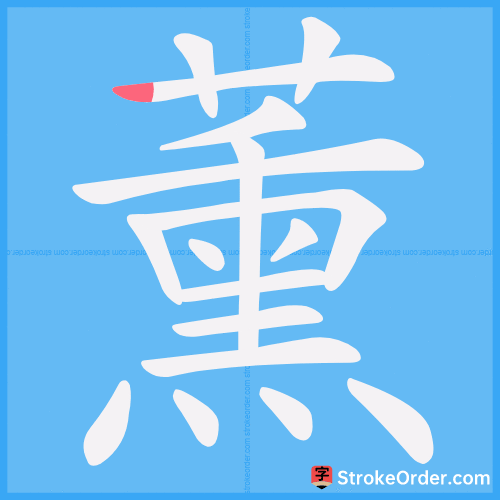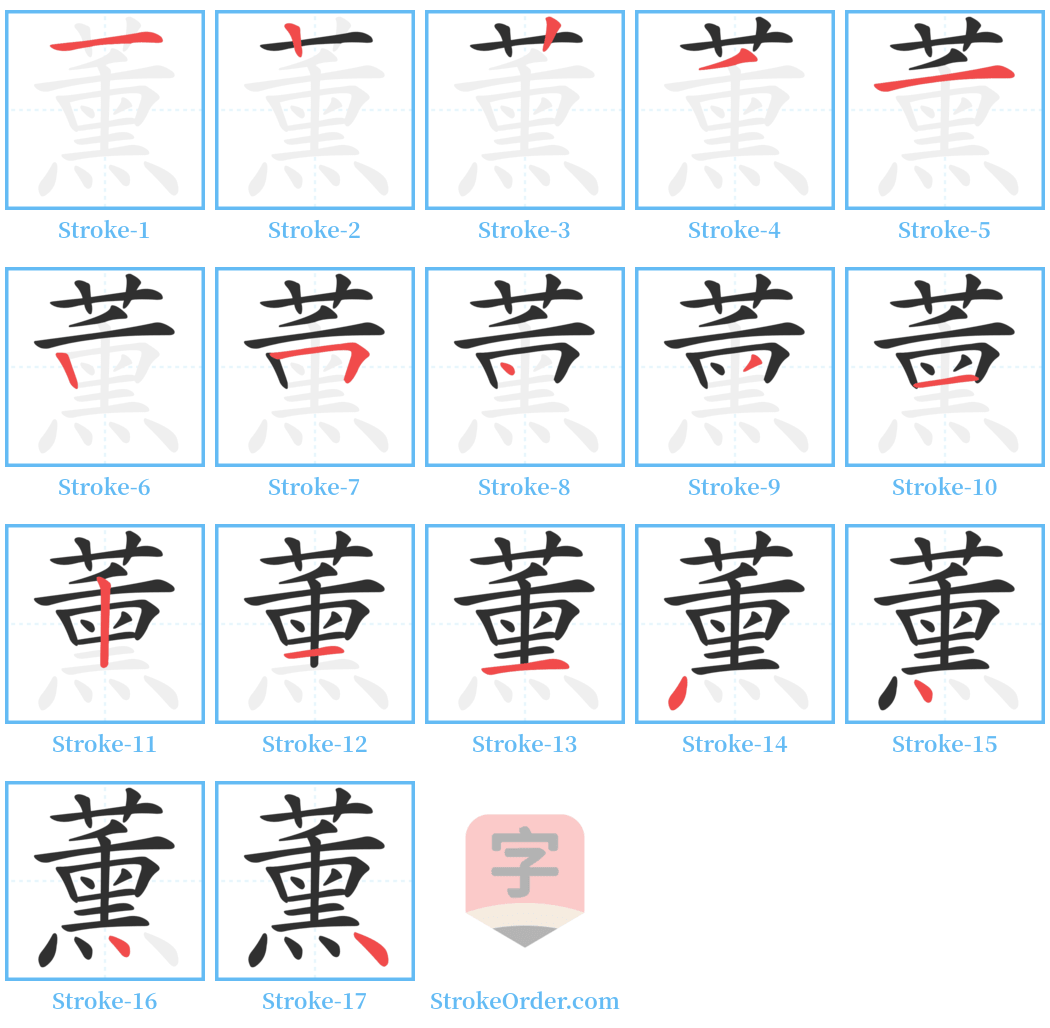薰 Stroke Order
Animated Stroke Order of 薰

Stroke Order Diagrams for 薰

Step-by-Step Handwriting Guide for 薰

Learn to Write Chinese Characters with Video Tutorials
Watch the video of writing the Chinese character "薰", learn the correct stroke order (笔顺) of the character "薰", and master the standard way of writing the character "薰".
Free Printable Handwriting Practice with Stroke Order: 薰
Printable Writing Practice Worksheet of "薰" in Portrait Orientation (Tian Zi Ge)

Printable Writing Practice Worksheet of "薰" in Landscape Orientation (Tian Zi Ge)

Information of 薰
Pinyin
xūn
Radical
艹
Strokes
17 strokes
Usage
★★★★
Definition
to smoke / scent / fumigate
薰 [xūn]
名 (Noun)
1. 同“熏”。 (Same as "熏".)
2. 古书上说的一种香草,又泛指花草的香气。 (An herb mentioned in ancient texts, which also refers generally to the fragrance of flowers and plants.)
- 薰莸不同器 (The fragrant herb and the foul herb cannot be kept in the same vessel, metaphorically suggesting that good and bad cannot coexist. Also known as "薰莸异器".)
名 (Noun)
本义: 蕙草 (Original meaning: Hedyotis, also known as "零陵香" - holy basil.)
造字法: 形声。从艸,熏声。 (Phonetic-meaning structure: combines the grass radical with the phonetic sound "熏".)
1. 香草名。即“蕙草”,又名“零陵香” ([En.] holy basil)
2. 香气、香味 ([En.] aroma; fragrance of flowers)
- 引 (Quotations):
1. 《说文》:薰,香草也。 (“Shuowen”: "薰" means fragrant herb.)
2. 《广雅》:薰草,蕙草也。 按,即今零陵香。 (“Guangya”: "薰草" refers to "蕙草", which is today's holy basil.)
3. 叶曰薰,根曰薰是也。——《离骚》王逸注 (From "Li Sao": The leaves are called 薰, the roots are also called 薰.)
4. 《左传·僖公四年》:一薰一蕕。 (“Zuo Zhuan”: One fragrant and one foul herb.)
5. 《山海经·西山经》:浮山有草焉,名曰薰。 (From "Shan Hai Jing": There are herbs on Mount Fu, called 薰.)
6. 《淮南子·说林》:腐鼠在坛,烧薰于宫。 (From "Huainanzi": A rotten mouse in the altar, burn scents in the palace.)
- 例 (Example):
又如: 薰莸 (薰 and 莸, meaning a fragrant herb and a foul herb; metaphor for beauty and ugliness, or good and bad.)
薰草 (Referring to "蕙草", commonly known as佩兰.)
动 (Verb)
1. 以气味或烟气烤制物品。通“熏” ([En.] Treat meat, fish, etc. with smoke.)
- 引 (Quotations):
1. 《汉书·龚胜传》:薰以香,自烧,此用其根也。 (From "Han Shu": "薰" with fragrance, burns itself, uses its root.)
- 例 (Example):
又如: 薰鱼; 薰鸡; 薰服 (Fragrant clothing, referring to garments used by courtesans; clothing perfumed with scents.)
薰沐 (The use of fragrance and bathing to show respect.)
2. 感化。潜移默化地受影响 ([En.] Exert influence subtly.)
- 例 (Example):
如: 薰染 (Inspiration, moral influence); 薰修 (In Buddhist terms, refers to personal cultivation.)
3. 烧灼,熏炙 ([En.] Burn.)
- 引 (Quotations):
1. 谢惠连《雪赋》:燎薰炉兮炳明烛。(From "Xue Fu": "燎薰" refers to fire smoke rising.)
- 例 (Example):
又如: 薰戒 (Using incense to purify); 薰灼 (Using smoke and fire to cook); 薰心 (The heart suffers burning; often describes sorrow.)
4. 用香物涂身 ([En.] Apply fragrance while bathing.)
- 例 (Example):
如: 薰沐 (Using spices to cleanse the body, showing respect and purity.)
形 (Adjective)
1. 和暖,温和 ([En.] Mild.)
- 引 (Quotations):
1. 左思《魏都赋》:蕙风如薰。 (From "Wei Du Fu": "The gentle breeze is like 薰".)
- 例 (Example):
又如: 薰风 (Gentle wind, referring to the summer breeze.); 薰薰 (A warm, gentle appearance.)
2. 温和的样子 ([En.] Warm.)
- 引 (Quotations):
1. 《庄子·天下》:薰然慈仁。 (From "Zhuangzi": "Warm appearance of kindness.")
- 例 (Example):
又如: 薰然 (The appearance of warmth and gentleness.)
Input Method for 薰
Pinyin
xun1
Wubi
tglo
Cangjie
hgf
Zhengma
mebu
Four Corner
20331
Unicode
U+85b0
Same Pronunciation Characters